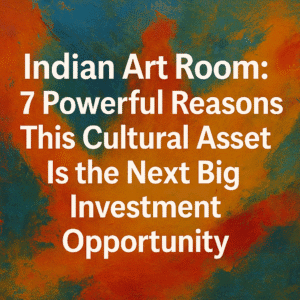Indian Art Boom: 7 Powerful Reasons This Cultural Asset Is the Next Big Investment Opportunity
Fueled by India’s robust 6.5–7% GDP growth and a surge in ultra-wealthy individuals, the art market crossed ₹1,000 crore in auction sales in 2023–24, signaling a paradigm shift. No longer confined to decorative appeal, art now blends cultural legacy with financial pragmatism—modern masters like Tyeb Mehta and M.F. Husain deliver 20–30% annual returns, rivaling global peers. NRIs drive 40% of demand, leveraging art as a tax-efficient bridge to heritage and a tangible inflation hedge.
Millennials are redefining luxury, prioritizing rare watches and art over traditional assets, while platforms democratize access via fractional ownership. Yet challenges persist: illiquidity, authentication gaps, and a lack of institutional frameworks demand cautious curation. As India’s cultural capital converges with economic ambition, art transcends aesthetics to become a storied asset class—where passion meets portfolio diversification.

Indian Art Boom: 7 Powerful Reasons This Cultural Asset Is the Next Big Investment Opportunity
India’s art market is undergoing a seismic shift, transcending its traditional role as cultural ornamentation to emerge as a formidable asset class. With auction sales surpassing ₹1,000 crore in FY 2023–24—a historic milestone—Indian art is now firmly on the radar of global investors. But what’s fueling this metamorphosis, and how does it reflect broader economic and societal trends?
- Economic Momentum Meets Cultural Pride
India’s projected 6.5–7% GDP growth isn’t just a macroeconomic statistic; it’s catalyzing a wealth revolution. The nation added 5,000+ ultra-high-net-worth individuals (UHNIs) in 2023 alone (Knight Frank Wealth Report), creating a cohort seeking to diversify beyond stocks and real estate. Art, with its dual appeal as a tangible store of value and a cultural emblem, offers a compelling proposition.
- Case in Point: Tyeb Mehta’s “Gestures” sold for ₹34 crore in 2023, doubling its 2018 value.
- Global Context: While Western markets dominate, Indian modernists like Souza and Raza now command 20–30% annual appreciation, rivaling mid-tier global artists.
- The “Dual Engine” Driving Demand
Unlike gold or equities, art uniquely straddles emotional resonance and financial pragmatism.
- Status Symbol: For India’s elite, owning a Husain or a Sher-Gil signals sophistication and roots.
- Inflation Hedge: With RBI’s inflation targets at 4–6%, art’s low correlation with traditional assets provides portfolio resilience.
- Global Precedent: The $68B global art market (Statista 2023) shows blue-chip art outperformed S&P 500 by 28% over 25 years (Citi Global Art Market Report).
- NRIs: Bridging Nostalgia and Financial Strategy
The NRI community—18M strong—is pivotal. Platforms like Saffronart and AstaGuru report 40% of buyers are overseas Indians, driven by:
- Cultural Anchoring: Art as a tangible connection to heritage.
- Tax Efficiency: Lower capital gains tax (12–18%) vs. global markets (up to 28% in the US).
- Succession Planning: Art’s portability and emotional value aid intergenerational wealth transfer.
- Watches, Wine, and Wisdom: The New Portfolio Paradigm
Luxury investments are no longer fringe. Millennials (30% of Indian UHNIs) are reshaping norms:
- Horological Boom: Rare Patek Philippes appreciated 15% YoY, per Deloitte.
- Art-Tech Synergy: Online auctions and blockchain-based provenance tracking mitigate authenticity risks.
Yet, art’s edge lies in its scarcity—only one original exists, unlike limited-edition watches.
- Risks and Realities: Navigating the Brushstrokes
While promising, the art market demands nuance:
- Liquidity Crunch: Selling a masterpiece can take years.
- Expertise Gap: 60% of new collectors lack access to curation advisors (McKinsey).
- Regulatory Gaps: India lacks a centralized authentication body, unlike France’s Art Loss Register.
The Road Ahead: Canvassing Opportunities
The market is poised for structural evolution:
- Fractional Ownership: Startups like ArtSlice enable micro-investments in high-value works.
- Institutional Participation: SEBI’s proposed Alternative Investment Fund (AIF) norms may include art.
- Cultural Infrastructure: Museums and fairs (e.g., Kochi-Muziris Biennale) enhance global credibility.
Conclusion: Painting a Future of Value
Indian art’s ascent mirrors the nation’s journey—rooted in heritage, yet audaciously modern. For investors, it’s a call to blend due diligence with passion: partner with reputed galleries, study market cycles, and recognize that true value often lies where culture and capital converge. As economist Eileen Kinsella notes, “Art isn’t just bought; it’s stewarded.” In this renaissance, every canvas tells a story—and for the astute, a legacy.
You must be logged in to post a comment.